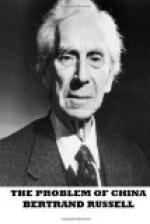The similarity of the influence of China in producing the Restoration of 645 A.D. and that of Europe in producing the Restoration of 1867-8 is set forth by Murdoch[43] as follows:—
In the summer of 1863 a band of four Choshu youths were smuggled on board a British steamer by the aid of kind Scottish friends who sympathized with their endeavour to proceed to Europe for purposes of study. These, friends possibly did not know that some of the four had been protagonists in the burning down of the British Legation on Gotenyama a few months before, and they certainly could never have suspected that the real mission of the four youths was to master the secrets of Western civilization with a sole view of driving the Western barbarians from the sacred soil of Japan. Prince Ito and Marquis Inouye—for they were two of this venturesome quartette—have often told of their rapid disillusionment when they reached London, and saw these despised Western barbarians at home. On their return to Japan they at once became the apostles of a new doctrine, and their effective preaching has had much to do with the pride of place Dai Nippon now holds among the Great Powers of the world.
The two students who went to China in 608 A.D. “rendered even more illustrious service to their country perhaps than Ito and Inouye have done. For at the Revolution of 1868, the leaders of the movement harked back to the 645-650 A.D. period for a good deal of their inspiration, and the real men of political knowledge at that time were the two National Doctors.”
Politically, what was done in 645 A.D. and the period immediately following was not unlike what was done in France by Louis XI and Richelieu—curbing of the great nobles and an exaltation of the sovereign, with a substitution of civil justice for military anarchy. The movement was represented by its promoters as a Restoration, probably with about the same amount of truth as in 1867. At the latter date, there was restoration so far as the power of the Mikado was concerned, but innovation as regards the introduction of Western ideas. Similarly, in 645 A.D., what was done about the Mikado was a return to the past, but what was done in the way of spreading Chinese civilization was just the opposite. There must have been, in both cases, the same curious mixture of antiquarian and reforming tendencies.
Throughout subsequent Japanese history, until the Restoration, one seems to see two opposite forces struggling for mastery over people’s minds, namely the ideas of government, civilization and art derived from China on the one hand, and the native tendency to feudalism, clan government, and civil war on the other. The conflict is very analogous to that which went on in mediaeval Europe between the Church, which represented ideas derived from Rome, and the turbulent barons, who were struggling to preserve the way of life of the ancient Teutons. Henry IV at Canossa, Henry II doing penance for Becket, represent the triumph of civilization over rude vigour; and something similar is to be seen at intervals in Japan.




